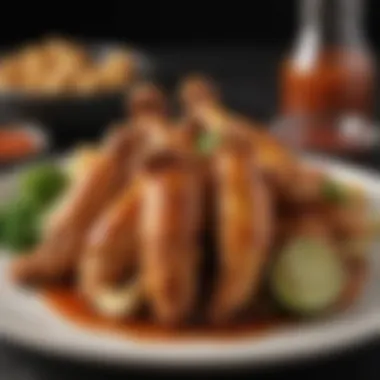Mastering Grilled Chicken Wings Marinade Techniques


Intro
Marinating grilled chicken wings is a culinary art that many aspire to perfect. With a wide range of options available, the right marinade can elevate the taste of chicken wings from ordinary to extraordinary. This article will offer a thorough understanding of various marinade techniques, essential ingredients, and the science behind flavor enhancement.
Grilled chicken wings are not just a favorite dish for many; they hold a prominent place in gatherings, parties, and casual meals alike. Understanding the nuances of marinating techniques empowers you to explore flavors that cater to different preferences.
"The secret to exquisitely flavored grilled wings lies in the marinade. It transforms simple chicken into a flavorful feast."
A well-executed marinade can add depth, moisture, and a myriad of flavor profiles to your grilled wings. In this exploration, we will dissect both traditional marinades and some innovative alternatives, ensuring you have the knowledge to craft an unforgettable dish. Let's take a closer look.
Prolusion to Marinades
Marinades are a crucial element in the culinary world, especially when it comes to grilled chicken wings. They serve a dual purpose: flavor enhancement and tenderization. By soaking the wings in a mixture before cooking, the flavors can penetrate the meat deeply, resulting in a taste profile that can transform even the most basic recipes into something rather special.
Another significant aspect of marinades is the science behind them. The ingredients in a marinade work together to break down the tough proteins in the meat. This process not only makes the chicken more tender but also allows it to absorb the flavors from the marinade. Understanding this foundational concept is essential for anyone looking to master grilling chicken wings.
Additionally, marinades can vary widely in composition. From simple combinations of oil and vinegar to intricate blends that include herbs, spices, and even fruit juices, the possibilities are nearly endless. This diversity means that cooks can tailor marinades to suit their tastes, dietary needs, or culinary inspirations.
Definition of Marinades
A marinade is a flavored liquid used to soak foods before cooking them. Typically, it contains an acid, such as vinegar or citrus juice, combined with oil, and various seasonings. The purpose of a marinade is to enhance the flavor of the food and to improve its texture. The acid in the marinade helps to break down proteins, leading to a more tender dish, while the oil facilitates moisture retention during cooking.
Historical Context
The practice of marinating has existed for centuries, with roots in various cultures around the world. In ancient times, people discovered that soaking meat in acidic solutions could help preserve it, especially before the invention of refrigeration. Historical texts show that civilizations, from the Romans to the Chinese, utilized marinades to enhance the taste of their food. Their diverse uses derived from the availability of local ingredients and cultural preferences. For instance, in Mediterranean cuisine, olive oil and lemon juice are common marinade staples, while in Asian cuisines, soy sauce and ginger play pivotal roles. Through time, the technique has evolved, but the fundamental principles remain the same.
Importance of Marinades in Cooking
Marinades play a significant role in a culinary context, particularly when it comes to grilled chicken wings. They are not only about adding flavor, but they also serve multiple purposes that enhance the overall dining experience. Understanding the benefits of marinades allows cooks to elevate their dishes and create memorable meals. Here, we delve into the specific aspects and advantages of this essential technique.
Flavor Enhancement
One of the primary benefits of using marinades is the ability to enhance flavor. A well-crafted marinade penetrates the meat, imparting rich and complex flavors. This process transforms simple chicken wings into a gourmet treat. Essential components of a marinade, such as herbs, spices, and acidic ingredients, work synergistically to create a depth of taste that is hard to achieve through seasoning alone.
For instance, using components like soy sauce or vinegar brings umami and tanginess, while fresh herbs like cilantro or parsley provide aromatic freshness. When marinated properly, chicken wings absorb these flavors, leading to a satisfying and enjoyable taste profile with every bite.
Texture Improvement
Beyond flavor, marinades improve meat texture through tenderizing. Acidic ingredients in a marinade, such as citrus juices or vinegars, break down proteins in the chicken. This process makes the wings not only juicier but also more tender. Deciding how long to marinate the chicken affects the outcome. A shorter marination might yield subtle texture modifications, while longer periods can provide a more pronounced tenderizing effect. This consideration is crucial for achieving the ideal mouthfeel, especially for those looking to enjoy a succulent bite.
Marinade vs. Brine
While both marinades and brines enhance food, they function differently and serve unique purposes. A brine is typically a salty solution that hydrates the meat. This process can draw in moisture, leading to juicier cooked chicken. In contrast, marinades are often more focused on flavor, although they can have a tenderizing effect as well.
Considering the differences, one can choose between marinating or brining based on the desired end result. For instance:
- Marinades are ideal for flavor infusion and texture improvement.
- Brines help enhance juiciness and ensure moisture retention during cooking.
Components of a Marinade
Understanding the components of a marinade is crucial to mastering the art of marinating grilled chicken wings. Each element plays a significant role in enhancing the flavor and texture of the wings. A marinade typically includes acidic ingredients, oils, and flavoring agents. These components work synergistically to penetrate the meat, ensuring a more flavorful and enjoyable eating experience. By recognizing the importance of these elements, one can create well-balanced marinades that cater to diverse palate preferences.
Acidic Ingredients
The backbone of any effective marinade is often its acidic component. Acids help to break down the proteins in meat, allowing flavors to penetrate deeply.
Citrus Juices
Citrus juices, such as lemon and lime, are commonly used in marinades. They provide a bright and zesty flavor that complements the rich taste of chicken wings. The key characteristic of citrus juices is their high acidity, which aids in tenderizing meat. This makes them a beneficial choice for imparting both flavor and texture. However, using too much citrus can cause the meat to become overly soft, leading to a mushy texture. Therefore, it is essential to balance citrus with other ingredients in the marinade.
Vinegars
Vinegars, such as apple cider or balsamic, enhance marinades with their complex flavors. The sharpness of vinegar works effectively to balance richness in chicken meat. They are popular due to their ability to provide acidity without overwhelming the other flavors. The unique feature of vinegars is their variety, allowing a range of taste profiles from sweet to tangy. However, excessive vinegar can dominate the marinade, potentially masking the taste of the chicken wings. Moderation is key when incorporating vinegars into a marinade.
Wine
Wine also serves as a versatile acidic ingredient in marinades. It adds depth and complexity to the flavor of chicken wings. The primary advantage of using wine is its wide range of varietals, each contributing different notes—from fruity to earthy. Wine's alcohol content helps dissolve fats, which can also enhance flavor penetration. One downside is that it might not be an ideal choice for everyone due to dietary restrictions. It’s essential to consider whether the audience appreciates wine flavor before including it in a marinade.
Oils and Fats
Oils and fats are critical in marinades, as they carry flavors and help in heat conduction during grilling.
Types of Oils
Different types of oils can alter the final taste of cooked wings significantly. Common choices include olive oil, canola oil, and sesame oil. Each oil has a distinct flavor profile, which can enhance or mellow other ingredients in the marinade. Olive oil is rich and fruity, while sesame oil adds a nutty touch. However, some oils have low smoke points, which may not be suitable for grilling, leading to undesirable flavors. It is important to choose oils that withstand high temperatures to maintain the marinade's integrity.


Impact on Flavor
The impact of oils on flavor is significant. They help distribute the marinade evenly and prevent the wings from drying out while grilling. The key characteristic is that they can retain and enhance spice flavors, leading to a more robust seasoning. Notably, oils can also contribute to a desired crispy texture on the wings when grilled properly. However, too much oil can make the dish greasy, undermining the overall experience. Thus, it is advisable to use oils judiciously in the marinade.
Flavoring Agents
Herbs, spices, and aromatics are what transform a simple marinade into a flavor-packed experience.
Herbs and Spices
Incorporating herbs and spices into a marinade adds complexity to the flavor. Fresh herbs like rosemary and thyme, or spices such as paprika and cumin, can create layers of taste in chicken wings. The unique feature of herbs is that they provide freshness and aromatic qualities, while spices introduce warmth and depth. While they are beneficial for enhancing flavors, the challenge lies in achieving the right balance. Overusing spices can lead to overpowering flavors that may not appeal to all palates.
Aromatics
Aromatics, like garlic and onions, provide a foundational flavor in many marinades. They release their essential oils, contributing beloved flavors and enhancing overall aroma during cooking. The key characteristic of aromatics is that they add depth, making the marinade more enticing. However, some may find certain aromatics pungent; hence, keeping their quantity moderate is essential. Balancing the use of aromatics ensures the marinade elevates the dish without becoming overwhelming.
In summary, mastering the components of a marinade allows for deeper flavor and better texture in grilled chicken wings. By skillfully balancing acids, oils, and flavoring agents, one can create marinades that stand out and complement the natural taste of the meat.
Classic Marinade Recipes for Chicken Wings
Classic marinade recipes serve as foundational elements in the art of cooking chicken wings. These recipes harness the power of traditional flavor combinations, enhancing the overall taste and texture of the chicken. By understanding these classics, cooks can appreciate why certain flavors work harmoniously together. Additionally, these recipes provide a reliable framework for those seeking to explore variations and innovate in their culinary practices. The balance of acid, fat, and seasoning in these marinades provides a superb guide towards crafting mouthwatering wings.
Lemon Garlic Marinade
The lemon garlic marinade is notable for its bright and zesty profile. The combination of fresh lemon juice and garlic offers both acidity and robust flavor. This marinade not only tenderizes the chicken but enhances its natural flavors. The acidity from the lemon juice breaks down proteins, ensuring that the wings absorb the marinade fully.
To prepare this marinade, simply combine the following ingredients in a bowl:
- 1/4 cup lemon juice
- 1/4 cup olive oil
- 3 minced garlic cloves
- Salt and pepper to taste.
This mixture can be adjusted to personal preference, using more or less garlic based on taste. Marinating the chicken wings for at least one hour, ideally overnight, allows the flavors to infuse deeply. After marinating, grilling the wings creates a delightful char and depth to the citrus profile.
Soy Sauce and Ginger Marinade
The soy sauce and ginger marinade reflects the rich flavors often found in Asian cuisine. Soy sauce injects a deep umami essence while ginger adds warmth and a slight heat. Together, these ingredients create a marinade that not only penetrates the wings' exterior but also enriches the flavor throughout.
To create this marinade, gather:
- 1/2 cup soy sauce
- 2 tablespoons fresh grated ginger
- 2 tablespoons sesame oil
- 2 tablespoons honey
- A pinch of black pepper.
Mix these ingredients thoroughly and allow the wings to marinate for several hours or overnight. This extended marination leads to a tender texture and an aromatic finish upon grilling, resulting in a savory experience.
Buffalo Sauce Marinade
There are few flavors more revered in the world of chicken wings than classic Buffalo sauce. This marinade is vibrant, with a perfect balance of heat and tang. Traditionally, Buffalo sauce consists of hot sauce, butter, and vinegar, but incorporating it as a marinade takes this flavor experience further.
For an effective Buffalo marinade, combine:
- 1/2 cup hot sauce
- 1/4 cup melted butter
- 2 tablespoons white vinegar
- A dash of garlic powder.
The melted butter provides richness, while the hot sauce delivers the signature punch. Allowing the chicken wings to marinate for at least an hour ensures every bite is flavorful, intense, and satisfying after grilling.
Creating Unique Marinade Combinations
Creating unique marinade combinations is a vital aspect of enhancing the flavor profile and overall culinary experience of grilled chicken wings. The ability to blend diverse ingredients offers an opportunity to not only explore various taste elements but also to infuse cultural significance into one’s cooking. This section will delve into how cultural inspirations and sweetener experimentation can elevate marinade techniques and concepts.
Cultural Inspirations
Mexican Influence
The Mexican culinary tradition emphasizes vibrant flavors, which can be effectively translated into marinades for chicken wings. Ingredients commonly found in Mexican cooking, such as lime, chili peppers, and cilantro, serve as the cornerstone of many marinades. The tangy, zesty nature of lime juice, coupled with the heat from chilies, creates a lively flavor that not only complements the chicken but also adds a distinct character to the dish.
One key characteristic of the Mexican influence is its emphasis on freshness. Fresh ingredients are often preferred over dried alternatives, resulting in a more intense and nuanced flavor. This makes Mexican-style marinades a popular choice for those seeking an engaging culinary experience. The unique feature of combining sweet, sour, and spicy elements lets home cooks explore bold flavors that can be adjusted to personal preferences.
However, potential disadvantages may include the need for more diverse ingredients that might not be readily available in every region. This could limit the accessibility for some cooking enthusiasts. Regardless of this, the benefits of using Mexican-inspired marinades often outweigh these challenges, delivering depth to grilled chicken wings.
Mediterranean Flavors
Mediterranean flavors draw on a variety of ingredients that have historical significance and health benefits. This region's cooking often features olive oil, garlic, lemon, and herbs like oregano and rosemary. These components not only enhance the taste of grilled chicken wings but also bring in a healthful aspect with their rich antioxidant properties.
The distinctive characteristic of Mediterranean marinades is their simplicity combined with robust flavors. This straightforwardness allows cooks to highlight the natural taste of the chicken while adding an aromatic depth through herbs and spices. The advantage of using these flavors is their broad appeal, suited for various palates and occasions.
Nevertheless, the uniqueness of Mediterranean ingredients may not cater to everyone’s taste. Some may find the flavors too subtle compared to bolder alternatives. Yet, the overall health benefits and balanced taste profile make Mediterranean flavors a beneficial addition to any marinade collection.
Experimenting with Sweeteners


Maple Syrup
Maple syrup stands out as a versatile sweetener that can balance savory elements in a marinade. Its unique flavor profile adds a depth that complements the smokiness of grilled chicken wings. The use of pure maple syrup can provide a natural sweetness that is not overpowering, enhancing the wings' overall profile without masking other key ingredients.
A noteworthy feature of maple syrup is its ability to create a glaze-like finish when grilled, contributing to an appealing appearance and texture. Its popularity in marinades often stems from its healthful reputation compared to refined sugars. However, using maple syrup may require careful balancing with acidic components to avoid cloying sweetness.
Honey Variations
Honey is another popular choice for sweetening marinades. Its diverse range allows cooks to experiment with different flavors, depending on the type of honey used, such as clover, wildflower, or orange blossom. Each variation brings its distinct aroma and taste to the chicken wings, allowing for creativity in flavor combinations.
One advantage of using honey is its natural preservative qualities, which can help prolong the marinade's shelf life. It can also encourage browning during grilling, resulting in an attractive color and improved flavor. However, honey can sometimes make marinades too sweet if not properly balanced with acidic ingredients, which necessitates precision in measurement.
Marination Techniques
Marination techniques play a crucial role in enhancing the flavor and juiciness of grilled chicken wings. A well-executed marinade allows ingredients to penetrate the meat, resulting in a more flavorful and tender dish. Understanding the specific elements, benefits, and considerations of different marination techniques contributes to achieving optimal results in any culinary venture. Thus, mastering marination is essential for cooking enthusiasts aiming to elevate their grilled chicken wings.
Timing and Duration
Short Marination
Short marination typically involves soaking the chicken wings in the marinade for a brief period, usually ranging from 30 minutes to a few hours. This method is beneficial when you want to infuse some flavor while keeping the cooking process efficient. The key characteristic of short marination is its ability to provide a quick flavor boost without excessive soaking time.
One unique feature of short marination is that it tends to preserve the natural texture of the chicken wings. By limiting the marinating time, the meat maintains its firmness, making it ideal for those who prefer a less saturated flavor. However, the disadvantage might be in the depth of flavor. A shorter soak does not allow the marinade to fully penetrate the meat, making it less intense compared to longer methods.
Overnight Rests
Overnight rests involve marinating the chicken wings for an extended period, generally 8 to 24 hours. This technique is one of the most favored approaches due to its ability to yield a profoundly infused flavor, enhancing the overall taste significantly. The primary characteristic of overnight rests is the extensive flavor absorption that occurs, allowing the marinade to fully penetrate the meat.
The unique aspect of an overnight rest is its potential drawback. While the benefits far outweigh the disadvantages, there is a risk of over-marinating, which can lead to a mushy texture, particularly with acidic marinades. Therefore, it is essential to select the right marinade components to avoid compromising the chicken’s textural integrity. Using this method results in wings that are deeply flavored, setting a solid foundation for further cooking techniques.
Storage Methods
Refrigeration
Refrigeration is a practical storage method that preserves the quality of both the chicken wings and marinades. Keeping the marinated wings chilled slows down bacterial growth, which is vital for food safety. The key characteristic of refrigeration is maintaining an optimal temperature that prevents spoilage without affecting flavor absorption.
This method is beneficial because it allows the wings to marinate effectively while keeping them safe to consume. However, one limitation can arise if the duration exceeds recommended times, leading to potential quality decline. To optimize refrigeration, ensure that the wings are in an airtight container to minimize exposure to air, which could affect flavor and texture.
Freezing
Freezing represents an effective long-term storage solution for marinated chicken wings. This method is especially useful when preparing ahead for gatherings or meal prep. The key characteristic of freezing is that it halts bacterial activity, preserving not just safety but the integrity of flavors as well.
One significant advantage of this method is versatility. Marinated wings can be frozen and then stored for several months, making them convenient for later use. However, the disadvantage lies in the thawing process. If not handled correctly, the wings may lose moisture and texture. Therefore, it is crucial to thaw in the refrigerator rather than at room temperature to prevent uneven texture and flavor loss.
Grilling Techniques for Chicken Wings
Grilling techniques play a pivotal role in achieving the perfect grilled chicken wings. Understanding the methods and tools available can greatly influence both the flavor and texture of the finished dish. Perfecting these techniques elevates the marinated wings, allowing the flavorful essence of the marinade to shine through. Furthermore, applying these methods can help avoid common pitfalls such as undercooking or uneven cooking, significant concerns while grilling.
Direct vs. Indirect Heat
The choice between direct and indirect heat is essential for grilling chicken wings. Direct heat involves placing the wings directly over the flame or heat source, which is effective for cooking wings quickly and achieving a crispy exterior. However, this method can lead to burnt surfaces if not monitored carefully.
Conversely, indirect heat involves placing the wings away from direct flames. This approach allows for even cooking over a longer period, making it suitable for larger quantities or thicker cuts. Using indirect heat also reduces the risk of flare-ups from the rendered fat, allowing the marinade flavors to meld without charring. Combining both methods is often an effective strategy, starting with direct heat for browning and finishing with indirect heat to ensure thorough cooking.
Use of Grilling Accessories
Grilling accessories can enhance the grilling experience and optimize the cooking results.
Grill Baskets
Grill baskets are a practical tool for cooking chicken wings. Their design allows for even heat distribution while preventing small pieces from falling through the grates. This characteristic contributes to convenience and prevents mess as you handle the wings on the grill.
Using grill baskets is popular because they simplify the grilling process. They can hold multiple wings securely, allowing for better flipping and moving without directly handlilng the meat. Additionally, many grill baskets are made of materials that can withstand high heat, ensuring durability. One downside, however, is that wings in baskets may not receive the same direct flame exposure as those placed directly on the grill, which can impact crispiness depending on preference.
Skewers
Skewers provide another excellent option to prepare chicken wings on the grill. They allow for easy manipulation and turning of the wings during the cooking process. They can also improve bite-size cooking, leading to a more enjoyable eating experience and allowing for different marinades on each skewer.
The key advantage of skewers is their ability to create an even cook throughout the pieces while maximizing the surface area exposed to heat. However, one consideration is that chicken wings can be delicate, making them potentially harder to manage on skewers compared to sturdier cuts of meat. Additionally, using wooden skewers requires soaking beforehand to prevent burning.
Food Safety Considerations
Food safety is a critical aspect of marinating and cooking chicken wings. Understanding the safety protocols can prevent foodborne illnesses, which can result from mishandling raw chicken. In this section, we will explore the importance of proper food safety when working with marinades, focusing on two key elements: safe handling of raw chicken and prevention of cross-contamination.
Safe Handling of Raw Chicken


When working with raw chicken, it is essential to understand the risks involved. Chicken is often contaminated with bacteria like Salmonella or Campylobacter. To ensure safe handling, it is advisable to follow these practices:
- Use Separate Cutting Boards: Designate one cutting board for raw chicken and another for fruits, vegetables, and ready-to-eat foods.
- Wash Your Hands: Use soap and warm water to wash hands thoroughly before and after handling raw chicken. This should be done for at least 20 seconds.
- Keep It Chilled: Store chicken in the refrigerator at temperatures below 40°F (4°C). Marinating chicken at room temperature can promote bacterial growth.
- Keep Products Separate: When shopping, make sure to separate raw chicken from other foods in your cart. This reduces the chance of unintentional contamination.
Cross-Contamination Prevention
Cross-contamination occurs when bacteria or contaminants from raw chicken spread to other foods or surfaces. This can easily happen in any kitchen if proper precautions are not taken. To minimize this risk, consider these strategies:
- Utilize Proper Storage: Store raw chicken in a leak-proof container to prevent juices from contaminating other foods in the refrigerator.
- Sanitize Surfaces: Clean and disinfect countertops, utensils, and dishes that come into contact with raw chicken using hot water and soap or a suitable disinfectant.
- Use Different Utensils: Avoid using the same utensils for raw chicken and cooked food without thoroughly washing them first. For example, using the same tongs can transfer harmful bacteria.
"Food safety is not a cost. It's an investment in health."
Incorporating these food safety measures ensures not only the health of the individuals consuming the chicken wings but also elevates the overall cooking experience by allowing you to focus on flavor without the worry of foodborne illnesses. Through safe handling and effective prevention strategies, the marinating process can be both enjoyable and secure.
Pairing Marinades with Sides
Pairing marinades with sides is an often-underestimated aspect of culinary preparation. When crafting grilled chicken wings, the right side dishes can enhance not only the flavor profiles of the wings but also the overall dining experience. The importance lies in achieving a balance that complements the various flavors present in the marinated chicken. Thoughtful pairing can elevate a simple meal into a gourmet experience.
In this context, every marinade imparts unique characteristics to the wings, such as a spicy kick or zesty freshness. Sides should reflect and enhance those attributes, creating a harmonious plate.
Complementary Flavors
Understanding complementary flavors is crucial in maximizing the impact of your chicken wings. For instance, if your wings are marinated in a spicy buffalo sauce, pairing them with a cooling side, such as a cucumber salad, creates a pleasing contrast. Conversely, a sweet soy sauce and ginger marinade may benefit from a slightly tangy fruit salsa, which can lift the richness of the wings. By carefully considering flavors that work together, you can create a more nuanced meal.
Ideal Side Dishes
Salads
Salads provide a refreshing counterpoint to rich or spicy marinades. They often feature crisp textures and bright flavors that cleanse the palate. A well-done salad can play an essential role in balancing the heaviness of grilled chicken wings.
One key characteristic of salads is their versatility; they can be customized to suit any marinades you choose. For instance, a light arugula salad with lemon vinaigrette pairs well with a rich honey-garlic wing marinade. The acidity in the dressing cuts through the sweetness, enhancing the flavors of both dishes without overpowering them. Salads are generally low in calories and high in nutrients, making them a health-conscious choice to accompany meats.
However, salads can be sensitive to dressings. Heavy oils or creamy dressings might clash with delicate wing flavors, so it's important to choose wisely.
Dips
Dips are another excellent side to accompany grilled chicken wings. They serve as flavor enhancers, adding additional layers of taste while keeping the meal engaging and interactive. Classic choices include blue cheese and ranch dressing, which complement spicy marinades well.
One reason dips are popular is their ability to add creaminess and richness to your meal. For instance, a tangy yogurt-based dip can offset the heat from wings marinated in a spicy blend. This creates a pleasing balance and invites guests to engage by dipping.
The unique feature of dips is their interaction with the main dish. They not only complement the wings but also provide texture variations that enhance the overall experience. The downside is that some diners might find dips overwhelming, so moderation is key for a sophisticated meal presentation.
Innovation in Marinade Crafting
Innovation in marinade crafting represents a crucial dimension in enhancing the flavor and appeal of grilled chicken wings. In culinary practices, innovation not only refers to utilizing new ingredients but also involves techniques that can transform traditional methods. As food lovers seek to diversify their cooking, innovating marinade recipes can evoke excitement and elevate dining experiences.
One key aspect of innovation is the incorporation of global ingredients. This approach allows cooks to infuse their dishes with unique flavors, enriching the overall taste profile. Many cultures have distinctive traditions when it comes to marinating meat. For example, Asian-inspired marinades often leverage ingredients like soy sauce, sesame oil, and ginger, which can drastically alter the flavor of chicken wings. Similarly, Middle Eastern marinades may include spices like cumin and sumac, lending a completely different depth to the dish.
Incorporating Global Ingredients
When considering global influences in marinades, flexibility is important. Adapting traditional flavors can bring excitement to standard recipes.
- Asian Marinades: Incorporating soy sauce, ginger, or garlic can create a savory profile. Sometimes, adding sriracha or sesame seeds enhances the spice level and texture.
- Latin American Influence: Ingredients such as lime juice, cilantro, and chili are popular. A marinade that includes chipotle peppers can add both heat and smokiness.
- Mediterranean Touch: Olive oil, lemon juice, and oregano often feature in Mediterranean cooking. These ingredients provide a fresh and vibrant essence to grilled chicken wings.
"Combining flavors from different cuisines is one of the best ways to discover new tastes and reinvent classic dishes."
Innovation requires also consideration of ingredient availability and personal taste preferences. It allows chefs to adjust traditional recipes and create something both familiar and new. By experimenting with various spices or cooking methods, marination becomes a creative process.
Fermented Ingredients for Depth
Fermented ingredients offer a unique avenue for flavor development in marinades. Ingredients like kimchi, miso, or even fermented hot sauces introduce tang and complexity.
- Miso Paste: Its salty umami flavor adds depth while tenderizing the meat.
- Kimchi Juice: Using the brine from kimchi can bring slight spiciness while enriching flavor.
- Kefir or Yogurt: Dairy products can also play a role in tenderizing and adding a creamy texture
Utilizing fermented ingredients not only enhances the taste but can also provide health benefits, such as probiotics, contributing to digestive health. By incorporating these elements, the marinade evolves beyond mere flavor and becomes a vital part of the entire culinary narrative.
Ending
In the context of this article, the conclusion serves as both a reflection on the significance of marinades and a bridge toward further exploration in culinary practices. Marinades have the unique ability to enhance the flavor and texture of grilled chicken wings, making them a crucial element in any cooking enthusiast's repertoire. By deeply understanding marinade techniques, one can not only elevate the quality of their dishes but also embrace a world of creativity in flavor pairing and ingredient combination.
Reflecting on the Importance of Marinades
The importance of marinades in cooking cannot be overstated. They act as a catalyst for flavor absorption, significantly impacting the outcome of the grilled wings. A well-crafted marinade allows chicken to soak in essential flavors while also tenderizing the meat, creating a more enjoyable eating experience. The balance of acidic, oily, and flavorful components determines the efficacy of the marinade, making knowledge of these elements essential.
As home cooks experiment with varying regional flavors and innovative ingredients, they contribute to their culinary growth. Moreover, understanding the science behind marination leads to better decision-making when selecting ingredients. Each marinade recipe offers insight into new flavor profiles, encouraging chefs to think expansively about their cooking.
Encouragement for Exploration
Culinary exploration is at the heart of cooking. As this article has unraveled various techniques and recipes, readers are encouraged to use this knowledge as a foundation for their kitchen experiments. The exploration of marinades opens a gateway to customizing flavors that align with personal preferences and cultural inspirations.
Try mixing traditional elements, such as citrus and herbs, with unexpected ingredients like fermented sauces or global spices. Each foray into different ingredients brings potential culinary surprises. Sharing findings and personal creations with others can create a collaborative cooking culture, enriching the overall culinary community.















